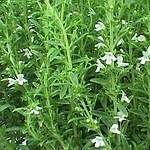| Common Name: |
Summer Savory |
| Genus |
Satureja |
| Botanical Name: |
Satureja hortensis |
| Family: |
Lamiaceae |
| Native Location: |
SE Europe |
| Cultivation |
Well-drained to dry, neutral to alkaline soil in sun. Satureja douglasii needs moist, sandy, slightly acid loam, and partial shade. Pinch out new shoots in spring to encourage bushiness. Cut back perennials in early spring. Winter crops of S. hortensis may be grown in pots in greenhouses at 7-10°C (45-50°F) or from seed sown in early autumn; it reputedly deters Mexican bean beetles if planted along rows of legumes. |
| Propagation |
By seed sown in spring at 13-16°C (55-61°F); by division in autumn or spring (perennials); by greenwood cuttings in summer (shrubby species). |
| Harvest |
Leaves are harvested during the growing season. Flowering tops are picked in summer. Both are used fresh, or dried for infusions and oil extraction. |
| Height: |
10-35cm (4-14in) |
| Width: |
30cm (12in) |
| Variations: |
Aromata
Is compact, with a stronger, superior flavor.
Originated in E Germany, where it is used for flavoring sausages |
|
| Hardiness |
Hardy |
| Parts Used: |
Leaves, flowering tops |
| Properties |
An antiseptic, astringent, warming, expectorant herb with a peppery flavor and high carvacrol content. It improves digestion, increases perspiration, stimulates the uterus and nervous system, and is reputedly aphrodisiac. |
| Medicinal Uses: |
Internally for indigestion, nausea, colic, diarrhea, bronchial congestion, sore throat, and menstrual disorders. Externally for sore throat and insect stings. |
| Culinary Uses: |
Leaves are used to flavor legumes, sausages, meat dishes, stuffings, and marinades (especially for olives). An ingredient of herbs de Provence (with Rosmarinus officinalis, See Rosemary, Thymus vulgaris, See Thyme, and Origanum spp. See Oregano). |
| Warning: |
Contraindicated during pregnancy. |
| Bibliography: |
Encyclopedia of Herbs by Deni Bown Copyright © 1995, 2001 Dorling Kindersley Limited. pp 361-362 |

